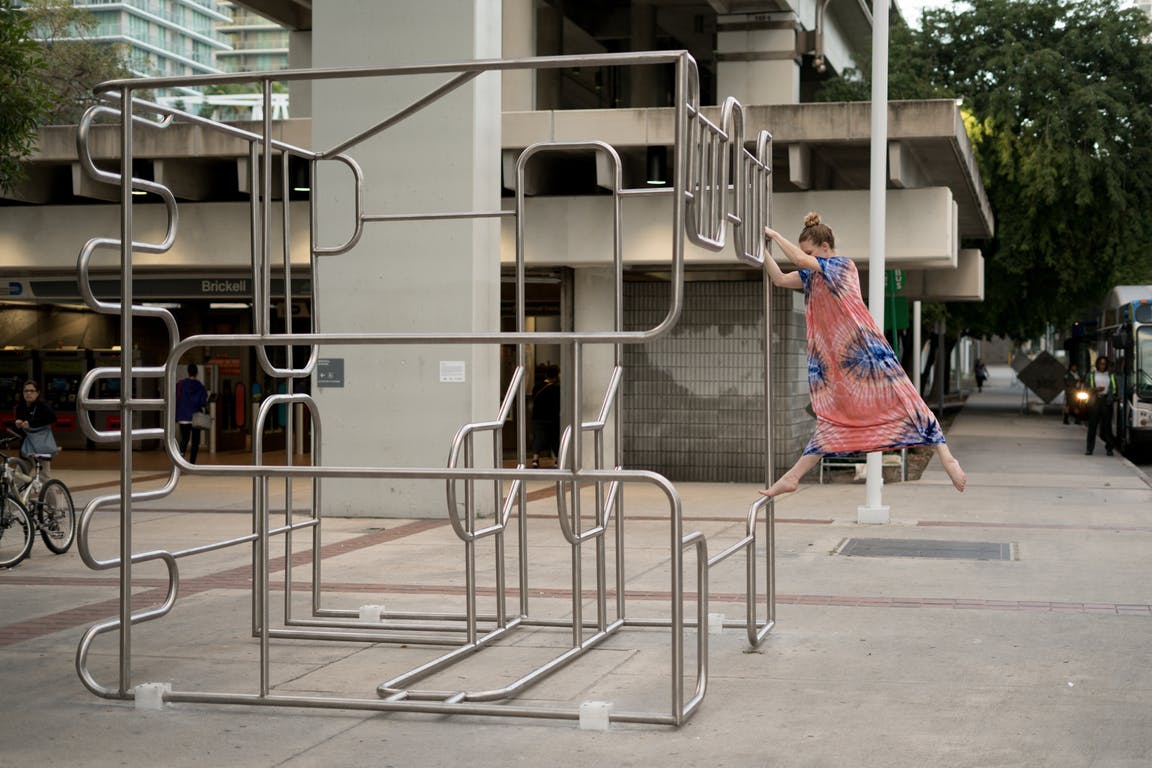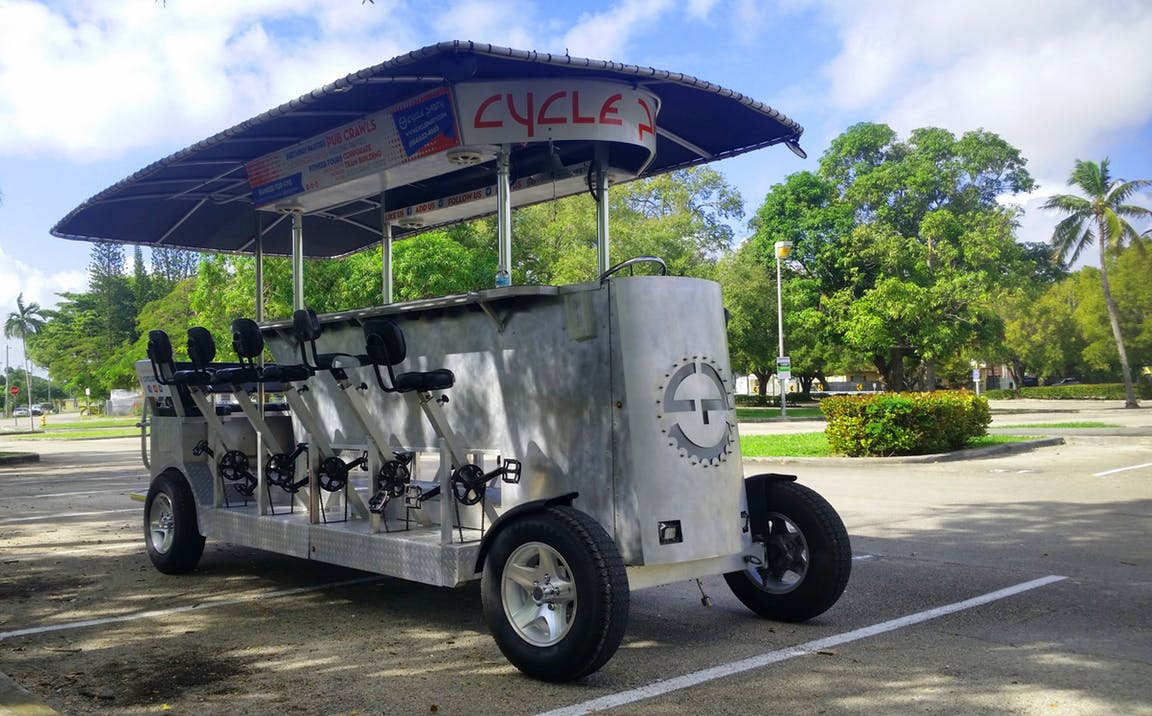
The Underline’s art and its place in Miami’s public space
The bright, cool afternoon boded well for the inauguration of The Underline public art program. Hired performers turned Nicolas Lobo’s steel sculpture into a jungle gym with their acrobatics, soon joined by kids passing the Brickell Metrorail stop where it was temporarily installed. Other spectators climbed aboard Agustina Woodgate’s mobile radio station, which required participants to pedal while they listened to issues about the environment and urban planning as the human-powered trolley rolled around the area. Joggers stopped to see New World School ballet dancers entwine themselves with a mirror and steel sculpture created by Naomi Fisher.
These intentionally interactive art projects were a perfect introduction to an ambitious project that will integrate public art with an eco-friendly, 10-mile park running under the Metrorail from Brickell to Dadeland South stations–under eight stations in all. In an otherwise hyper-developing section of the city, these swathes of land under the cold concrete rail line are neglected. By incorporating bike and walking trails, native landscaping and public art, The Underline aims to get people out of their cars and to discover a new urban world, hopefully intermingling and fostering a civic environment as well.
The master plan was created by the firm that designed New York City’s High Line, the widely popular public park created on a refitted elevated train line. The Underline follows that blueprint, and is a collaborative project of various Miami-Dade County departments: Cultural Affairs’ Art in Public Places; Parks, Recreation and Open Spaces; Transportation and Public Works; and the nonprofit Friends of The Underline. Along with public funding, The Underline is also a winner of a Knight Cities Challenge. This first arts part of the urban park is an Art in Public Places project, made possible by an ArtPlace America grant. Future artworks will be commissioned by Friends of The Underline.

Four local artists with a track record of working in varied media comprised the initial grouping: Bhakti Baxter, Naomi Fisher, Nicolas Lobo and Agustina Woodgate. Like the linear park, the artwork is meant to be mobile, fluid, to keep people moving, and also to keep them engaged in their surroundings.
Lobo’s “Brutal Workout” was on this day outside the Brickell stop (it is moving around to various stations through March). It’s a handsome sculpture in its own right, a stainless steel 10-foot by 10-foot cube with curved and straight bars within the frame. To “activate” it, several performers wrapped their bodies around the sculpture. Soon, the people getting off the train, or biking and walking by who had stopped to observe decided to join in. Younger ones in particular climbed all over it. The sculpture became more than a thing of beauty, but a part of the scene.

Passersby wondered what this was all about, and Amanda Sanfilippo, curator and artist manager of Art in Public Places, was on hand to fill them in, and point them to other aspects of the project. For instance, walking under the rail line along a path to another spot south, Fisher was setting up her installation, which would include ballet dancers practicing and stretching on the barres that snaked around her sculpture, made of large-scale, laser-cut steel and mirror puzzle pieces, for “#Puzzled.” Fisher has moved into producing multi-disciplinary events in recent years, pulling together visuals arts, performance and music that take place in alternative spaces. This is one such example.

Meanwhile, Woodgate was leading tours on her 16-seater live radio lab bike-trolley on the streets around the Metrorail. Members of the public took a stool, placed their feet on the pedals, donned head phones and joined in a conversation about development, conservation and art with guest experts, which were being recorded. Woodgate and the driver reminded the riders that while lively discussion was critical, so was continual pedaling, as navigating the congested streets on this unique eco-art trip required mental and physical input.
On this writer’s journey, talk revolved around New Urbanism planning, and the nature of the public art that was being unveiled. Answered Woodgate, “It’s all a project in motion.” These short tours are part of Ciclo, a podcast that will be whittled down to one hour of recollections from these bike-trolley trips along The Underline, which will premiere in the Metrorail sound system in March. To hear unedited archives, go to radioee.net.
Baxter’s sculptural contributions are more planted, literally. Inside the eight stations, he has created “Metro Flower Power”–large, lovely and subtle floral arrangements set in “pots” made from different materials and styles reflecting Miami. But they will not be permanent either. When this segment of the public art project comes to an end, the plants will be relocated outside along The Underline paths, which will be transforming into the linear park.
“We want to add cool and interesting art to our city” as part of this innovative new park, said Debi Wechsler, chair of The Underline Art Advisory Committee. “We want the art to engage and be interactive,” she said, with the ultimate goal of making a place that is “so beautiful, that you will want to walk and bike and be outside…..and get to know the City of Miami.”
Some of the art will be permanent, others rotating, and will be created by both local and national artists, said Wechsler. But the next phase won’t begin until The Underline paths are widened and paved, surrounded by native plantings and butterfly gardens, and better lighting. The shovels will hit the ground in the fall, and likely the second phase of artworks will go up in early 2018. It will include “pop-up galleries,” said Wechsler, “set in old train cars. Metrorail will have new trains in a year” and the discarded ones will be put to use. Art might be borrowed from institutions, or created for the sites. This roll-out will also take place at the Brickell station, and then move southward.
The art is not meant to be the basis of a traditional sculpture park, but “part of an environmentally friendly excursion,” she said, bringing people outside and bringing art to the people.
Recent Content
-
Artsarticle ·
-
Artsarticle ·
-
Artsarticle ·
